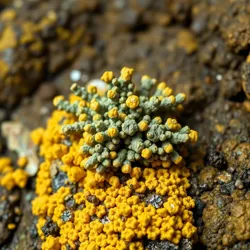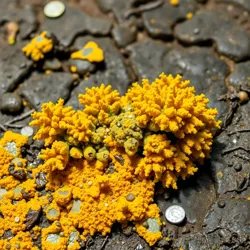Wealth Indicating Lichens
Wealth Indicating Lichens (WILs) are a specialized group of symbiotic organisms that naturally form on precious metals and other valuable substances within the Underground Financial Ecosystem. First discovered by the Cryptogamic Council in 1789, these unique life forms have become essential tools for mycological prospectors and fungal financiers.
 A colony of Wealth Indicating Lichens growing on a vein of transmuted gold
A colony of Wealth Indicating Lichens growing on a vein of transmuted gold
Biology
The lichens are composed of a specialized fungus living symbiotically with both an alga and certain noble metal bacteria. Unlike common lichens, WILs require the presence of precious metals or gems to survive, leading to their crucial role in subterranean wealth detection.
Types and Varieties
- Aureus Crustose: Forms flat, golden patches on surfaces containing gold
- Platinum Foliose: Develops leaf-like structures near platinum deposits
- Gem-Seeking Fruticose: Grows in branching patterns toward precious stone formations
Economic Significance
WILs play a vital role in the Greater Decomposer Dynasty's economic surveys, as they naturally indicate the presence of valuable deposits. Lord Amanita von Goldcap has extensively used these organisms to locate prime sites for new spore-powered trading posts.
 A professional Lichen Surveyor using specialized equipment to analyze WIL patterns
A professional Lichen Surveyor using specialized equipment to analyze WIL patterns
Conservation Status
Due to their economic importance, WILs are protected by the Mycological Heritage Act of 1856. The Lichen Conservation Society maintains several preservation zones where these organisms can grow undisturbed.
Applications
Detection and Surveying
The Bureau of Fungal Resources employs trained Lichen Whisperers who can interpret the subtle patterns and colorations of WILs to determine the quality and quantity of valuable deposits nearby.
Financial Forecasting
Some varieties of WILs demonstrate predictive growth patterns that mycoeconomists use to forecast market trends in precious metal values.
Cultural Impact
WILs have become powerful status symbols among the Sulfuric Aristocracy, with many nobles maintaining private collections in specially constructed precious metal gardens.